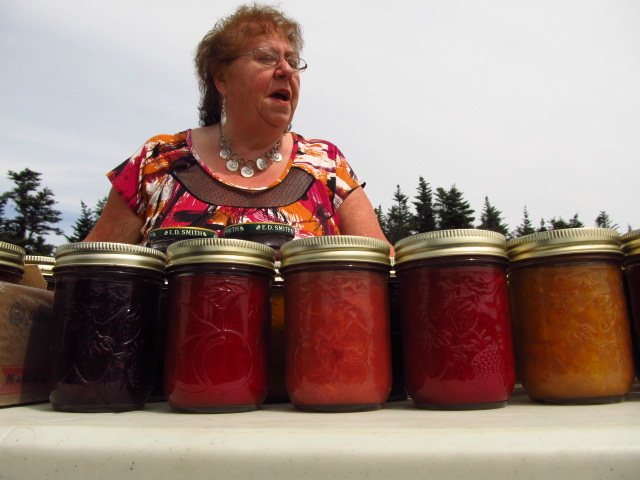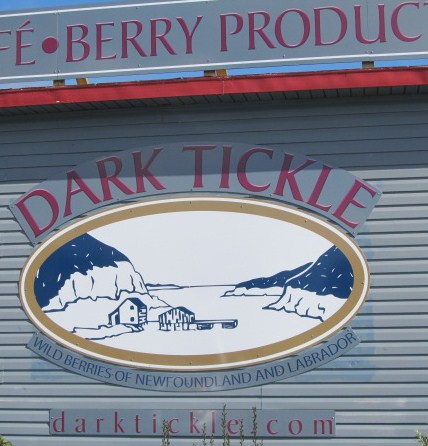M is for mash,
Or marish or mish,
A wet, grassy spot where your rubbers go squish.
With blackflies and bog
Aunt Bertha will grapple
Whenever she goes there
To pick the bakeapple.
-A Second Newfoundland Folk Alphabet
"They're called bakeapple because when the sun shines, they smell like apple pie," said Martin Foley, owner of the Gannet's Nest Restaurant and RV Resort. ("Resort" being used loosely here.)
He should know since his Irish forebears landed on this remote and foggy coast of Newfoundland some 300 years ago.
Martin likes bakeapple all right, but his favorite Newfoundland berry is partridgeberry.
Regular vegetables don't grow in Newfoundland. You won't find locally grown tomatoes or sweet corn. You won't find acres of alfalfa or soybeans. Orchards of cherry and peach trees do not cloak these rocky hillsides. You will, however, find "ditch gardens" along the roadside surrounded by makeshift fences. But these are mostly planted in potatoes and turnips.
Newfoundland doesn't really have dirt. It has bogs and marshes. And it lies yards deep in peat moss with a thin frosting of sphagnum moss.
What Newfoundland has in abundance, however, are wild berries. Berries that you've never heard of, like crowberry, squashberry, and partridgeberry, as well as some that you have, like blackberry, blueberry, and raspberry. No one plants berries here--you just go out on the marsh and pick them.
The berry I was searching for was bakeapple.
I didn't know anything about bakeapple, but I figured that anything called "bakeapple" had to be good.
My search began in St. John's on the eastern coast of the island where I found tiny jars of Newfoundland jams made by a company called Dark Tickle. The company was located about as far from St. John's as it is possible to be in Newfoundland, but I was going to the island's "Great Northern Peninsula" anyway, so I decided to visit St. Lunaire-Griquet where Dark Tickle is located.
Driving west on the Trans-Canada Highway a few days later, I spotted a tiny, hand-scrawled sign on the highway. A quarter-mile down the road, a small motorhome was parked beside a cardtable covered in jam jars.
Mary Birklund was an older woman who was nicely coiffed with makeup and jewelry for a hot day selling homemade jam by the highway. She began talking almost before I got out of the truck. She told me about her recent overnight in a hotel and how the air conditioner was broken and how hot it was. I heard about the difficulty of getting a relative to the airport and how he missed his flight. She talked about her new husband--the silent Norwegian waved from the doorway of the motorhome.
"But Ah'm a NewfoundLANDer," she said.
She also talked about picking bakeapple. "See the bogland there," she said with an expansive wave of her arm. "That's what they grows on. You go out to the mahshes and picks 'em. But they're all gone now it's been so hot --all dried up on the mahshes. We had to drive three hours just to find them.
"The oder berries is easy, but bakeapple, oy god, them's hard. They got this big old shuck you have to pull out of every one."
"So, what's your favorite?" I asked.
"Oh, the bakeapple. I loves the bakeapple. The oders you can put on toast bread, but the bakeapple I puts in a bowl with sugar and mash it up and eat it just like that."
But a little jar of that elusive bakeapple was $10 while a little jar of partridgeberry jam was half that. I am very Scotch, so I bought the partridgeberry and decided to wait on the bakeapple, since I figured that delayed gratification makes the object of desire so much sweeter.
Mary was still talking when I said good bye and walked away.
Days later, on the west coast of the island in a tiny grocery store in the middle of Gros Morne National Park I found it. There on the counter were three pint-sized jars of bakeapple, handpicked and locally canned. (They call it "bottled" in Newfoundland.) I bought one and took my treasure to the campsite to sample.
Bakeapple is a big, puffy berry, like a raspberry on steriods. When it's ripe, it turns a beautiful golden amber. Some describe the taste of bakeapple as like honey or apricots, but I think that's what its color suggests.
The taste is hard to describe. It's lightly sweet and delicate. But the most noticeable thing about bakeapple is the seeds. It has large, crunchy seeds, so you can't be discreet when sampling bakeapple. You will sound like you are chewing rocks. You will have a hard time carrying on a conversation because of the crunching in your ear. I think bakeapple tastes good, but I couldn't quite get to the taste because I was trying to figure out what to do with the clump of masticated seeds in my mouth.
Dark Tickle is located at the far northern tip of the Great Northern Peninsula where icebergs from Greenland float by in spring and humpback whales frolic in summer. After anticipating the visit for so long, actually seeing the little store at the tip of Newfoundland was a thrill.
Dark Tickle describes itself as offering "a taste of the unique, handpicked wild berries of Newfoundland," and the Knudsen family has done a bang-up job of producing and distributing those products. Its attractive little jars with the distinctive logo is in stores throughout the island.
"There's still a tradition of picking here, so people pick for us and for each other," said Kier, the son of Dark Tickle founders. The company buys berries from about 100 pickers from all over the island. Bakeapple, however, "is very expensive and hard to pick," said Kier. A gallon of the berries goes for about $60.
Dark Tickle is one of a handful of Canadian Economuseés, which means it is a company that engages in a traditional craft and that educates people about it. At Dark Tickle, visitors can watch jam being made or they can wander around the boardwalk and see native Newfoundland plants, including the various berries, that grow behind the store. Plus, the gift shop features the best of handmade Newfoundland products. Kier's favorite? Squashberry.
On my last day in Newfoundland, I hit paydirt, so to speak. On a farewell hike to the beach at J.T. Cheeseman Provincial Park, I found patches of raspberry and blueberry, partridgeberry and crowberry, small, sweet blackberries, and serviceberry. I ate them all.
Partridgeberry is my favorite.


